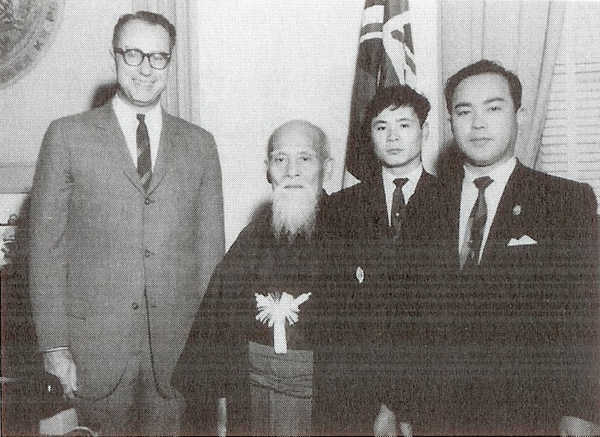
Nobuyoshi Tamura with Morihei Ueshiba O-Sensei and Koichi Tohei
meeting Hawaii Governor William F. Quinn in 1961
An interview with Aikido Shihan Nobuyoshi Tamura
This article is Part 2 of the translation of an interview with Nobuyoshi Tamura which originally appeared in “Profiles of the Founder” (開祖の横顔), published in Japanese in 2009. See “Profiles of the Founder of Aikido: Nobuyoshi Tamura, Part 1” for Part 1 of the interview.
When Tamura arrived in Hawaii as Morihei Ueshiba’s Otomo in 1961 he was immediatly nicknamed “the Stone Wall” because of his ability to remain immovable before the efforts of the local Hawaiian Aikido students.
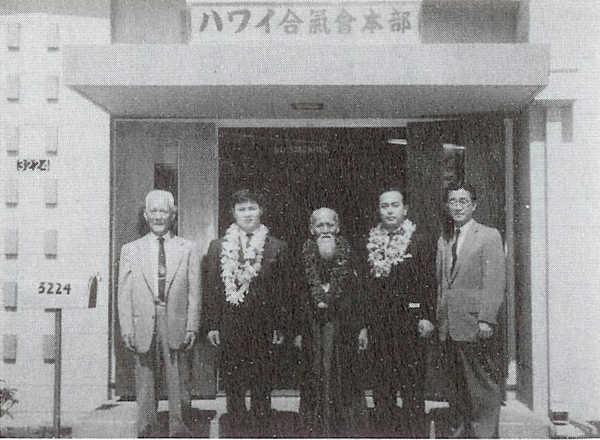
Nobuyoshi Tamura with Morihei Ueshiba O-Sensei in front of the Honolulu Aiki Dojo
(ハワイ合気會本部 – Hawaii Aikikai Hombu)
A Short History of French Aikido
(English translation by Christopher Li)
Q: Then, after you had spent ten years at Hombu…
A: I left because I was going to get married, I was around thirty years old.
Q: And after that you left for France, didn’t you?
A: No, that’s not right. At that time my wife was playing the violin, and some time after we met I asked Osawa (Kisaburo) Sensei, “We would like to get married, could you speak to her parents?”. Then her parents, who were probably looking for a way to refuse, said, “Our daughter is going to Europe to study the violin.”. At that I said, “Well, I’ll go too!” (laughing). So there was no way to get around giving their permission, and the two of us went to Europe together.
Q: So your trip overseas had nothing to do with Aikido?
A: No, I went as an Aikido instructor. At that time there were invitations from many foreign countries.
Q: Speaking of France, wasn’t that the territory of Tadashi Abe, the Aikidoka who was known as a fighter?
A: Abe had returned to Japan at that time。Around then Nakazono (Mutsuro) Sensei, who was in France, came up with travel money from the local people. Just one or two years before, my fellow Uchi-Deshi Noro-kun went, and I followed after. They said, “We’re building an Aikido Dojo”, but when I got to Marseille there wasn’t anything there yet (laughing).
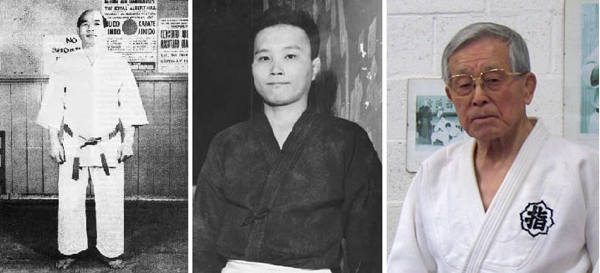
The three “Abe” – Kenshiro Abbe, Tadashi Abe and Ichiro Abe
Q: So you must have had many struggles after that.
A: Well, I was young, and I had a wife. At that time Judo was very popular in France, and Nakazano Sensei was teaching Aikido at the Provence Judo Club, which was run by a person who was the former French Judo champion. I also went to teach the Foreign Legion with Abe Sensei, I have a lot of anecdotes. At that time the name “Abe” was very famous. There were three Budoka named “Abe”, one was the Judoka Kenshiro Abbe (阿部 謙四郎 – one of only four Judoka to defeat Masahiko Kimura), and of course one of them was the Judoka Ichiro Abe (currently a 10 Dan in the Kodokan), and then Tadashi Abe. Tadashi Abe-san was especially famous for fighting (laughing). With a person like this playing the bulldozer and opening the road for me, even a greenhorn such as myself could make it. Previously, there were also people like Minoru Mochizuki Sensei. Mochizuki Sensei was also trained in Katori Shinto-Ryu kenjutsu, so in Mochizuki Sensei’s time he stood against both wrestlers and fencers.
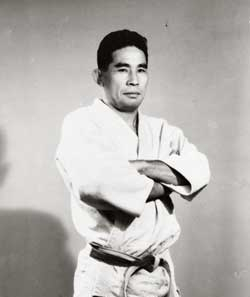
Yoseikan Aiki-Budo Founder Minoru Mochizuki, around 1951
Q: Sensei, were you acquainted with Mochizuki Sensei?
A: I went to the Dojo in Shizuoka as Otomo to O-Sensei a few times, and Mochizuki Sensei would come to Hombu Dojo on occasion as well.
Q: Is there anything about Mochizuki Sensei that stands out in your mind?
A: I was told “What you guys are doing now isn’t real Aikido”. That’s really a terrible thing for someone who is such a senior to you to say and I really resented it, but I was told, “This is Aikido” by O-Sensei and I have protected that as I continued in my training. I was told “After the war O-Sensei just changed the techniques however he pleased”, so I thought “After all, people from before the war are different”.
Q: Sensei, from your base in France you went to teach in many areas of Europe, but what about a Dojo?
A: I live in Marseille (France), but I don’t have a Dojo of my own.
Q: In France there are many people like Mochizuki Sensei’s son Hiroo Mochizuki Sensei (Yoseikan Budo Dai-Nidai Kancho) and André Nocquet, who we spoke of earlier, who are spreading Aikido.
A: The circumstances behind that are somewhat complicated. If you were speaking of a Budo Federation around the time that I came here (Showa year 39, 1964), the Judo Federation (FFJDA – “French Federation of Judo, Jujitsu and Related Disciplines”) was the only one in existence. When we attempted to register Aikido with the French government we were told to join that organization, and there was a strong reaction against being made subordinate to Judo in the Aikido community. Fortunately, there was a “Black Belt Association” organization dedicated to preserving the teachings of Jigoro Kano Sensei, and these people were willing to give us some assistance. After that, in order to form a single group, the GAN (Group André Nocquet), who had previously submitted to the Judo Federation, Yoseikan (HIroo Mochizuki), and our AFCA (“Association Culturelle Francaise d’Aikido” = Aikikai) entered the Judo Federation and laid plans to hold seminars to instruct in technique, unify the Dan-Kyu system, and unify the system of instructor certification. In 1975 (Showa year 50) member numbers also increased with the establishment of the International Aikido Federation.
While that was occurring Karate became independent from the Judo Federation, and as the one country-one martial arts federation model of organization was destroyed, we also intended to become independent. The OK was given by everybody at the general meeting, but when we actually became independent only one third of the membership followed, and we had to go back to the drawing board. Learning from General de Gaulle’s “Forces Francaise Liber” (FFL – “Free French Forces”), we created the FFLAB (“La Fédération Française Libre d’Aikido”). When the FFLAB was recognized by the government, the “L” (“Liberty”) was removed and the organization became the FFAB. After that, the Aikido groups remaining in the French Judo Federation became independent as the FFAAA with the backing of the Judo Federation. Upon a request from the French Ministry of Sport, talks to unify these two organizations have continued for more than ten years, and recently the government seems to have come around to the idea of recognizing two separate groups. Currently, each group has around 30,000 members, for a French Aikido population of around 60,000.
Harmony born in the midst of severity
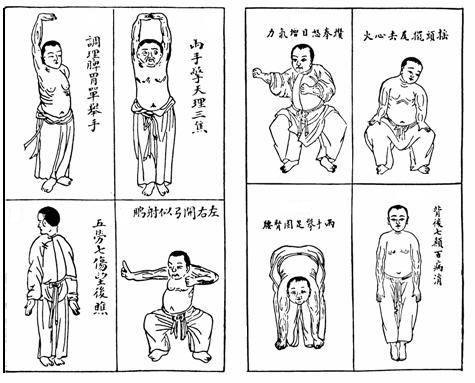
“Eight Pieces of Brocade” (Baduanjin qigong – 八段錦氣功)
Q: Sensei, you gave instruction in something like Kokyu-ho during this seminar, what exactly was that?
A: Kokyu-ho? Ah..it’s an exercise. It’s a Chinese health method called “Eight Pieces of Brocade” (Baduanjin Qigong – 八段錦氣功). After teaching in England one day, one of my juniors said, “Sempai, take a look at this”, and lent me a book. When I tried it I thought it was pretty good, so I started integrating it into my training. Also, I did Jikyou Jutsu (a Japanese method of health exercises – 自彊術), and integrated some of those exercises into the warm-ups.
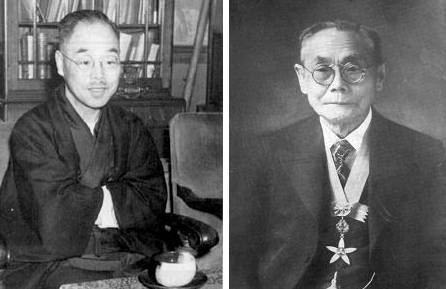
Katsuzo Nishi (西勝造 / 1884-1959) and Kenzo Futaki (二木謙三 / 1873-1966)
Q: You’re really introducing a lot of innovations…
A: There is a tradition of that in Aikido, from the time of O-Sensei. Makko-ho (Japanese Yoga – 真向法), Katsuzo Nishi Sensei’s Nishi Health System), or the health methods taught by Kenzo Futaki (Misogi no Renseikai – 禊の錬成会), O-Sensei would try things himself and if he thought they were interesting he would have the students do them as well. He would say “This is good”, or “This is no good!” (laughing). He would make us do it, but would tell us, “Stop if you feel like something’s wrong”. I still do things like the Nishi Health System goldfish exercise every morning without fail. Also, after doing the JIkyou Jutsu exercises I am instantly able to stand in a relaxed and natural posture, so they are very effective when you aren’t feeling well. This is difficult when you are training with a partner, but when doing them alone you are able to see inside yourself. To find whether or not an exercise is good for you personally, just try it at first and you will understand by whether it feels good or not.
Q: By making adjustments to your body you also increase your sensitivity for Budo. Wouldn’t this be even more effective if it were taught from a young age?
A: That’s right. However, with children their ability to comprehend is not yet fully developed, so if they do it badly there is a danger that they will be imprinted with something by mistake. For that reason, in my Dojo children do things that will interest them and we are careful not to force them too hard.
Q: You must have had many struggles in your long tenure teaching Aikido abroad…
A: When Budo was first known by the people of Europe they heard that Japanese Budo is not just the force of arms, but that the spiritual side is also important. Hearing that, everybody began to learn things such as Judo. However, those who could not see the important spiritual side in the midst of supremacy in competition came to look for that in Aikido. For that reason, I must also study. Of course, the Shinto words given to us by O-Sensei, but also such things as the Buddhist teachings at the base of Japanese Budo – I had many specialized texts sent to me from Japan. Thank you to everybody who helped me in my studies.
Afterword
There were a couple of things from the interview that stood out to me as particularly interesting.
Tamura makes no mention of Koichi Tohei, although Tohei was one of the dominant figures during the time that Tamura spent in Hombu Dojo (Tamura does mention Tohei in other interviews). In fact, Tamura accompanied Tohei to Hawaii when he came with O-Sensei as his Otomo – for a look at that trip through Tohei’s eyes, see “Morihei Ueshiba: Untranslatable Words”
As always, Tamura comes across as humble and unassuming, which is refreshing. Tamura’s emphasis on self study, both of the physical and the intellectual kind, is also both refreshing and impressive.
This last one probably comes as no surprise, but this passage from Minoru Mochizuki caught my eye:
君らが今やっているのは、本当の合氣道じゃない
What you guys are doing now isn’t real Aikido.
There is no question that Mochizuki comes with impressive credentials, which makes this a difficult statement to ignore.
Mochizuki was sent from the Kodokan (actually, he volunteered) to study with Morihei Ueshiba in 1930. Previous to that he trained directly with Judo Founder Jigoro Kano, and lived with Judo legend Kyuzo Mifune.
Kano was said to have told Mochizuki, “You have the makings of a leader… In the future you will be a top teacher here at the Kodokan”.
Tenshin Shoden Katori Shinto-Ryu actually wanted to adopt Mochizuki into the family to make him the successor to the art – and Aikido Founder Morihei Ueshiba also made him the very same offer before the war, when it was thought that Kisshomaru Ueshiba would not be able to follow his father as the inheritor of the art.
After the war, O-Sensei asked Mochizuki to take over Aikikai Hombu Dojo in Tokyo, but Mochizuki declined, fearing that it would eventually become a difficult situation with the Ueshiba family – as Koichi Tohei experienced some years later.
As if that’s not enough, Mochizuki was also the direct student of Shotokan Karate Founder Gichin Funakoshi!
Mochizuki would sometimes visit the Aikikai Hombu Dojo in Tokyo to teach or to visit, but not to train, he was in France for several years and then primarily at the Yoseikan dojo in Shizuoka. Apparently, there were changes in Tokyo that he felt damaged or removed what he considered to be the essence of Aikido training.
For those who are interested in how such changes may have occurred, I recommend Stan Pranin’s excellent article “Is O-Sensei Really the Father of Modern Aikido?“.
Christopher Li – Honolulu, HI


![Aikido, qué no sabemos y por qué no lo sabemos ... [Spanish Version] 武産合気](https://www.aikidosangenkai.org/blog/wp-content/media/takemusu-aiki-hideo-takahashi.jpg)


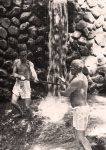
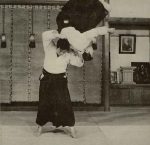
Leave a Reply